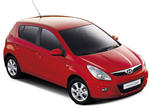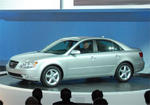
Hyundai unveiled a new range of Advanced Eco-Dynamic vehicles at this year's Geneva Auto Show -Hyundai i-blue concept. The Hyundai i-blue concept is very close to the production version and is powered by a new 0.8 liter 3 cylinder turbocharged engine. The Hyundai i-blue also presents the i-blue Package which includes improvements for the aerodynamics, powertrain, chassis and transmission.
Hyundai Press Release:
Hyundai Unveils i-blue range of Advanced Eco-Dynamic vehicles
- Technology that works today -
- The i-blue concept is a practical and near-production concept
- i-blue combines currently available technologies to achieve a significantly higher degree of efficiency
- i-blue package
- newly developed 0.8L 3 cylinder turbocharged engine
- CNG (Compressed Natural Gas) Application


At the Geneva International Motor Show Hyundai Motor Co. will be presenting the i-blue concept, an optimized combination of currently available technologies (i-blue package) with a completely new engine and a CNG application. The i-blue concept allows mass-production of highly eco-friendly vehicles - today.
CO2 emissions are at the core of eco-politics - Hyundai can make even further progress in reducing CO2. As the need to reduce green house gases, cut consumption and preserve resources becomes ever more imperative, new developments are crucial. With the i-blue concept,
Hyundai has combined several cutting edge technologies to meet ever-rising customer and legislative demands.
The result is a range of technologies, based upon the i10, i10 CNG, i30 and the forthcoming i20, engineered to set new practical standards in CO2 reduction and fuel economy.
“The i-blue concept can be thought of as an introduction of features that will naturally evolve in
future Hyundai cars. But if distributor, dealer and public demand justifies it, could become a stand-alone eco-dynamic model range. Either way, given the fact that we already produce class leading vehicles in terms of CO2 reduction, for example the current Santa Fe CRDi, it is a practical demonstration of the on-going commitment of Hyundai to both our customers and the eco-sphere,” explains Hans van Gent of Hyundai Motor Europe Technical Center GmbH.
Visibly distinguished by the i-blue badges, each model offers significant reductions in pollution, without compromising performance, reliability and driving satisfaction.
i-blue Package Content:
Hyundai i-blue video:
While the individual models differ in the exact combination of i-blue features, the overall package comprises advances in drag reduction, increased engine and transmission efficiency, and chassis fine-tuning.
Aerodynamic Improvements:
To achieve a major (up to 10%) reduction in Cd drag coefficient, the i-blue package includes:
- Vehicle specific full under-floor streamlining
- Aerodynamically optimized wheel housings, front and rear
- Optimized front air intake and rear spoiler
Elements that combine to achieve a major reduction in fuel consumption include:
- Increasing the inner motor efficiency by reducing driveline friction, using low friction oil, and optimizing the cooling system
- Changing the engine software control. For example, controlling injection pressure and engine cycle timing, along with enhanced exhaust re-treatment rates, and lowering the engine idling speed
- Fitting an ECU controlled gear change indicator (shift indicator)
- Adopting the Bosch Start & Stop system (incl. intelligent generator)
Chassis
In order to maximize both aerodynamic and fuel efficiency gains, the chassis will be further fine-tuned. Changes include:
- Suspension lowered by circa 15-20mm
- Adoption of very low resistance Michelin tires (i30: 205/55 R16) with increased tyre pressure
Transmission
Hyundai research has shown that changing from a 5 to a 6-speed gearbox and extending the top three ratios delivers a significant reduction in engine speeds with a corresponding reduction in consumption and emissions. Changes include:
- Replacing 5-speed with 6-speed manual gearboxes
- Extending the ratios of the top three gears
- Mounting the shift indicator directly in the instrument display
i-blue Vehicle Range
i30 blue
With the 90PS new 1.6CRDi diesel engine, the i30 5-door emits an impressively low 125 g/km CO2. With the i-blue package, this is reduced by 15.2% lowering the CO2 emissions to just 106g/km. Naturally, this percentile reduction is also reflected in reduced fuel consumption.
i10 blue
Introduced in 2007, the i10 brought a new sophistication to the entry level of the Hyundai range. The highly economic 75PS new 1.1CRDi 5-door already has a very low emission level of just 114 g/km CO2. With the essential elements of the i-blue package, this can be reduced to just 95 g/km. A meaningful 17% reduction.
i10 blue CNG
The ultimate solution of an ecologically optimized vehicle however is achieved through the bivalent combination of the newly developed 0.8L 3-cylinder turbocharged engine (98PS) and a CNG application. In this package, the i10 blue CNG reaches class leading level of just 65g/km CO2.
Hyundai and the Eco-Sphere
Our First Steps
Hyundai has always been at the forefront of ecological consideration. From the very beginning, we have offered our customers the best possible economy combined with technology designed to protect them and their world. Long before legislation arrived, Hyundai had cut pollution in all of its factories and introduced recycling codes.
One major example of our commitment was the commissioning of the Asan plant in 1996. To build this plant, some 1,700 trees were uprooted and replanted on reclaimed land in Namyang. All emissions were strictly controlled, and also as Hyundai were among the first major manufacturers to fully commit to water-based paints, and reduce dangerous elements such as cadmium, so were residual pollutants.
That same year, Hyundai announced the ULEV (Ultra Low Emissions Vehicle) that met or exceeded even the most stringent demands for emission reduction. We also developed our own ozone-friendly air conditioning gas and an anti-freeze that lasted for over 100,000 kilometres.
Fuel-Cell Vehicle Development
With the introduction of the Santa Fe SUV, a fuel cell powered edition made its debut in 2000 and was successfully tested in everyday use in the USA. In 2004, the second generation fuel electric vehicle was introduced based on the Tucson SUV platform and featured numerous refinements including sub-zero starting capability. Competing against teams from Daimler AG, GM, and Nissan, the Tucson FCEV was the only fuel cell electric vehicle to earn a perfect score in the 2007 Challenge Bibendum held in Shanghai. Challenge Bibendum, created by Michelin in 1998, is a competition promoting sustainable road mobility and covering four performance test parameters: noise, fuel efficiency, pollutants and CO2 and emissions.
The Tucson FCEV is capable of reaching a maximum speed of 150km/h and has an operating range of 350km using a hydrogen storage tank pressurized at 350 bar. The heart of this 21st century vehicle is an 80kW fuel cell stack independently engineered and developed by Hyundai.
For a Greener Society
In the 2007’s Panasonic World Solar Challenge race held in Australia, the all-new Hyundai i30 1.6 CRDi turbo diesel trumped an array of diesel and hybrid rivals to top the fuel efficiency and greenhouse gas emission stakes. Competing in the Greenfleet Technology Class, the i30 CRDi consumed just 3.2 litres of fuel per 100km and emitted just 97g of CO2 per kilometer traveled over the 3,000km journey from Darwin to Adelaide-outperforming not just Toyota´s Prius hybrid but also the diesels of Audi, Peugeot and even a BioBike.
The seeds for this recent harvest of accolades were planted in the 1990s when Hyundai began to invest intensively for the independent development of technology that could anticipate and meet all international anti-pollution legislation. The outcome of this early concentration of technicians, facilities and resources can be seen in our current range of engines, which comfortably meet or exceed Euro 4 norms while returning outstanding fuel consumption economy figures.
In 2004, Hyundai began to implement a programme to further co-ordinate its international environmental commitment and increase its efficiency. This intra-company environmental committee with specialist sub-committees ensures that environmentally friendly behaviour is a guiding principle throughout the world.
Few other companies can demonstrate this level of environmental involvement. So to us, i-blue is the next logical and practical step in providing our customers with the best proven, most reliable and affordable ecological technologies, while honouring our on-going commitment to their world.















